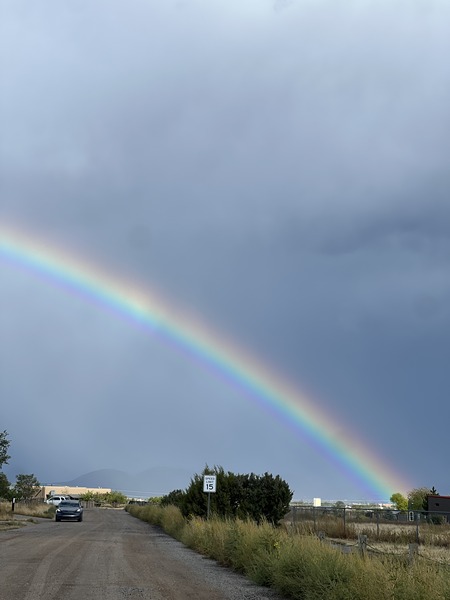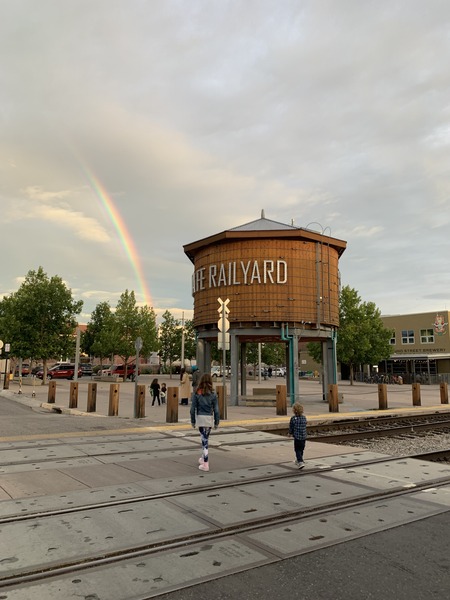This op-ed by Meredy Talbot-Zorn, a Santa Fe-based policy and advocacy consultant and a co-founder of the Rainwater Alliance, and Erin English, Senior Engineer and Practice Leader at Biohabitats, originally appeared in the Santa Fe New Mexican on May 10th, 2025. It is republished here with permission.

Santa Fe should build on its exceptional legacy in water conservation by leading the nation in rainwater harvesting.
Over the past three decades, Santa Fe has been a national leader in water conservation, cutting per capita usage nearly in half. Policies like tiered water pricing, water-saving plumbing codes and public education campaigns have inspired cities across the Southwest.
Today — in an era of megadroughts and unpredictable precipitation — Santa Fe should seize the next opportunity to scale up a simple and effective water-saving solution: catching more of what falls from the sky.

Santa Fe should enact a bold agenda to lead the nation in harvesting rainwater.
Our region’s Pueblo and acequia traditions instill deep respect for every drop. Communities here have historically managed water cooperatively and celebrated life-giving summer rains. Modern rainwater harvesting technologies extend these traditions: Rain from rooftops — on municipal buildings, homes, warehouses and factories — flows into tanks, where it’s filtered and used for toilet flushing, landscaping or industry. Rainwater is gaining traction as a solution to scarcity.

Recently, Apple and Toyota built rainwater harvesting systems at U.S. corporate campuses. Cities including Tucson, Ariz., and Austin, Texas, have passed extensive rainwater collection incentives and requirements. While some argue that Santa Fe’s limited rainfall makes harvesting less effective, numerous studies confirm even small amounts of rain, strategically captured, can significantly alleviate water shortages, recharge groundwater and reduce flooding, among other benefits. Rooftop harvesting is cost-effective and far less carbon-intensive than traditional water delivery systems.
Santa Fe County already leads by requiring new homes and businesses to include cisterns or water-harvesting earthworks. Yet Santa Fe’s public officials, candidates for office, and business and nonprofit leaders can go further.
Here are three practical ideas:
- First, the city should install large-capacity rainwater systems on at least 10 prominent city-owned buildings early in the next mayoral term. Libraries, schools and community centers can visibly demonstrate the benefits of catching rain. Santa Fe’s midtown district, for example, presents prime opportunities for a proof of concept. These installations can pay for themselves over time and inspire residents and businesses to harvest rainwater.
- Second, our city should expand incentives for businesses, developers and homeowners to install rain-harvesting systems. Enhanced rebates, streamlined permitting and property-assessed clean energy (PACE) financing make capturing rainwater accessible and financially attractive. The economics of rainwater are a lot like solar: It’s an upfront investment that enhances sustainability, resilience and pays for itself over time through reduced utility bills.
- Third, expand and scale efforts to integrate green stormwater infrastructure into streets, parks, open spaces and parking areas. Bioswales, rain gardens and permeable pavement beautify neighborhoods, boost property values, mitigate the heat island effect and reduce municipal costs by managing stormwater effectively. They also enhance water quality in the Santa Fe River and support groundwater recharge.

This will be a team effort for our community. Mayoral candidates and local officials should commit funding and support for rainwater harvesting projects. Businesses can seize investment opportunities, nonprofits can educate and facilitate installations, and financial institutions like the New Mexico Climate Investment Center, our state’s new “green bank,” can help offer attractive financing options.
In a time of so much polarization, the simple efficient use of water is an issue that can bring together everyone from industry to environmentalists. Rainwater presents an opportunity for Santa Fe to boost resilience, strengthen our economy, honor our cultural traditions and lead the nation on a timely climate issue.
Here in New Mexico, we’re living in an era not just marked by scarce water — but wildly unpredictable precipitation. Let’s make the most of the precious water that we receive.

